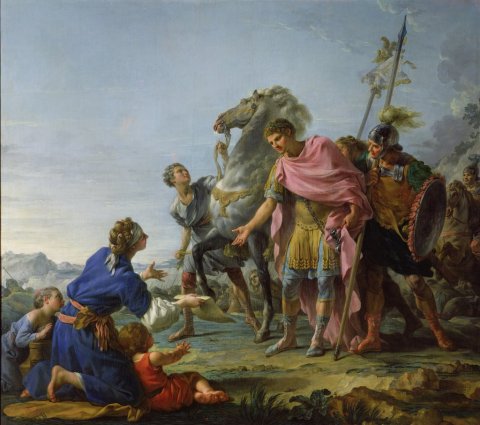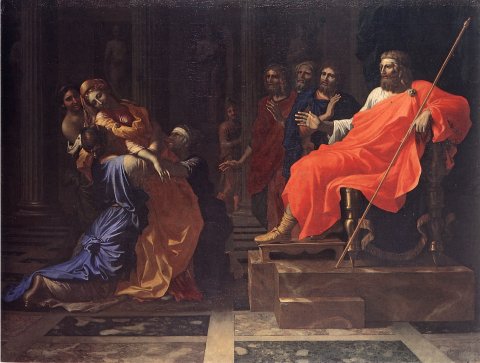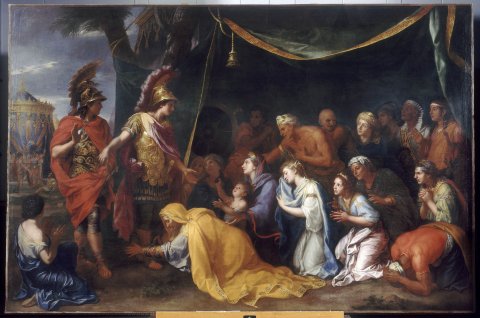[p.66]
Happy
15. Emperor Trajan, leaving on a hurried military expedition, dismounts his horse to hear the complaint of a poor woman1.
Large painting intended for Choisy.

The Trajan occupies the center and front of the painting. He is watching, listening to a kneeling woman, some distance from him between two children. [p.67] Next to the emperor, in the background, a soldier holds his prancing horse by the bridle; this horse is not at all the one Father Canaye asked for and of which he said: Qualem me decet esse mansuetum2. Behind the supplicant another woman stands. To the right, in the background, the appearance of some soldiers.
Monsieur Hallé, your Trajan imitated from the antique is flat, without nobility, without expression, without character; he looks as if he's saying to this woman: Good woman, I think you're tired; I'd lend you my horse, but he's shady as a devil... This horse is indeed the only remarkable character in the scene; it's a poetic horse, nebulous, grayish, such as children see in the clouds: the spots with which we wanted to speckle his chest imitate very well the dappled sky. The Trajan's legs are made of wood, stiff as if there were a lining of sheet metal or tin under the fabric. His coat is a heavy blanket of badly dyed crimson wool. The woman whose facial expression was to produce all the pathos of the scene, who stops the eye with her big blue cloth, all right, we can only see her from the back; I said the woman, but it may be a young man3; we need [p.68] that I believe there on her hair and the booklet, there is nothing that characterizes her sex. Yet a woman is no more a man from behind than from the front; it's another bun, other shoulders, other loins, other thighs, other legs, other feet; and that big yellow rug I see hanging from her belt in apron fashion, which folds under her knees and which I find again from behind, she had apparently brought so as not to spoil her beautiful blue dress; never was this voluminous piece of cloth part of her garment when she was standing. And then there's nothing finished either in her hands, arms or hairstyle; she's affected by the plica polonica4. That cloth, covering his forearm, is furrowed Saint-Leu stone5. Trajan's whole side is colorless; the too-clear sky puts the group in halftone and completes its death. But it's this emperor's arm and hand that should be seen, the arm for the stiffness, the hand and thumb for the incorrectness of the drawing. History painters treat these minutiae as trifles, they go for the grand effects; this rigorous imitation of nature stopping them at every step, would extinguish their fire, stifle their genius: isn't that true, Monsieur Hallé? That wasn't quite the view of Paul Veronese6, he went to the trouble of making flesh, feet, hands; but we've recognized their uselessness, and it's no longer the custom to paint them, though it's still the custom to have them. Do you know what that child on the front doesn't [p.69] look like badly? a cluster of large magnifying glasses7; they're only on his leg, undulating like a snake, a little more swollen than on his arms. This pot, this copper domestic utensil on which the other child is leaning, is of such a strange color that I had to be told what it was. The officers who accompany the emperor are as ignoble as he is. In your opinion, don't these little bits of figures scattered around indicate the presence of an army? This painting is without consistency in its composition, it's nothing, but nothing either for the color which is of past grass juices, nor for the expression, nor for the characters, nor for the drawing; it's a big enamel8 quite sad and quite cold.

But9 this subject was quite thankless. You're wrong, Monsieur Hallé, and I'll tell you how someone else would have made the most of it. He would have stopped Trajan in the middle of his web. The principal officers of his army would have surrounded him; each of them would have shown on his face the impression of the suppliant's speech. See how the Esther of the Poussin stands before Ahasuerus10. And what prevented your grief-stricken wife from being similarly grouped and supported by women of her state? Do you want her alone and on her knees? I agree; but for God's sake, don't show me her back: backs have little expression, whatever Mme Geoffrin may say. Let her face show me all her sorrow; let her be beautiful, let her have the nobility of her state; let her action be strong and [p.70]pathetic. You didn't know what to make of her two children; go and study The Family of Darius, and you'll learn there how subordinates are made to compete for the interest of the main characters. Why not designate the presence of an army by a crowd of heads pressed to the emperor's side? A few of these border-cut figures would have made me imagine as many more as I wanted. And why does the scene on the woman's side remain unwitnessed and unspectacular? Was there no one, not relatives, friends, neighbors, men, women or children, who were curious to know the outcome of her action? Here, it seems to me, is something to enrich your composition; instead of everything being sterile, insipid and naked.

Notes
Qualem me decete esse mansuetum; I hear a little Latin, says the Marshal; mansuetum would be better for sheep than for horses. Let them give my horse to the Father, I love his order, I am his friend, let them give him my good horse. [...] I went to dispatch my belongings, and didn't stay long without joining the convoy. We passed happily, but it was not without fatigue for poor Father Canaye. I met him on the march on M. d'Hocquincourt's good horse: he was a whole horse, ardent, restless, always in action; he eternally chewed his bit, always went sideways, hennissed from moment to moment; &, which greatly shocked the Pere's modesty, he indecently took all horses approaching him, for cavales.
And what do I see, my Father,I said to him as I approached him; what horse have you been given there? Where is the good Pere Suarez's mount, which you asked for so much? "Ah! Monsieur, je ne puis plus, je suis roué... He was about to continue his complaints, when a liévre starts: a hundred horsemen scatter to chase, & more pistol shots are heard than at a skirmish. The Father's horse, accustomed to fire under the Marechal, took his man with him, and made him pass all these stragglers in no time at all. It was a pleasant thing to see the Jesuit at the head of them all, in spite of himself." (Saint-Évremont, Conversation de M. d'Hoquincourt, in L'Esprit de Saint-Évremont, Amsterdam, 1761, p. 235-6)
The legend was very famous in the Middle Ages; it is notably described by Dante in the Divine Comedy in the form of a painting adorning Purgatory (Canto X, 73-94). As Trajan leaves for war, a young widow throws herself at his feet and presents him with a placet. Her son has been killed, and she asks for justice. Trajan begins by asking her to wait until he returns from the war. "My Lord, what if you don't come back?" And he: "Whoever is in my place will avenge you." But she: "What good will the good done by another be to thee if thou neglectest that which is thine?" And he then: "Now, be satisfied, for I must fulfill my duty before I go, justice wills it, pity keeps me here." Dante,
" Father Canaye, who found himself without a mount, asked for one that could carry him to camp. "And what horse do you want, mon Pere?" said the Marshal. Je vous répondrai, Monseigneur, ce que répondit le bon Père Suarez au Duc de Medina Sidonia dans une pareille rencontre : Qualem me decet esse, mansuetum; tel qu'il faut que je sois, doux et paisible?
Mathon de la Cour, in his Lettres, pointed out the same ambiguity: "there are people who doubt whether the person who asks justice from Trajan, is a man or a woman. Artists cannot too much avoid similar obscurities; they make in their works as bad an effect as in a speech, & I do not know why there are so many Painters whose compositions are obscure." (Lettres à Monsieur ** , sur les Peintures, les Sculptures & Gravures, exposées au Sallon du Louvre en 1765, p. 13.)
Criticism of the suppliant's hairstyle and tangled hair: "the plique was characterized mainly by the abundance, length and entanglement of the hair, which had become greasy, inextricable, gathered in braids, tufts, buns, populated with lice and nits, and exhaling a foul odor; sometimes even the same alteration was noted in the hair of the armpits and pubic area. " (Alfred Hardy, Trapractical and descriptive treatise on skin diseases, 1886.)
Saint-Leu stone, named after the quarries in Saint-Leu-d'Esserent, in the Oise department, where it was quarried, is a limestone, known as Lutetian limestone, composed in the quarries of different deposits, or benches. The upper bench, or banc royal, may have alternating hard and softer benches, giving it what Diderot called a "furrowed" appearance. The royal bench has been massively exploited as building stone, since the 14th century.
In the Palais-Royal gallery of the Duc d'Orléans, where he had his entrances thanks to Montamy, Diderot was able to see a Embrasement of Sodom by Veronese, among others; an Enlèvement d'Europe ; Mercure, Hersé et Aglaure (Utpictura18, notices A1539, A1545, A1547).
7" Loupe, surgical term, tumor that forms under the skin in the cells of adipose tissue. This tumor is circumscribed, without heat, pain, & without change in the natural color of the skin covering it. The skin is not adherent to it, & one feels in its center a fluctuation sometimes very-sensitive, & sometimes more obscure. The loupes are enkistées humors..." (Encyclopédie, IX, 704, article by Antoine Louis)
Enamel "is a particular preparation of glass, to which different colors are given, sometimes by retaining some of its transparency, sometimes by removing it" (Encyclopédie, V, 533a). Of a Lagrenée Virgin, Diderot writes: "Sachez qu' [...] il n'y a rien, ni grands défauts, ni grandes beautés; qu'on le prendrait pour un morceau d'émail, et qu'en général tous les morceaux de Lagrenée tiennent un peu enamel..." (Ver., IV, 840).
Diderot imagines the intervention of Hallé, who defends himself.
Diderot was writing the Salons at home, with an engraving after Poussin's Esther and Ahasuerus in front of his eyes.
Les Salons de Diderot (édition)
Archive mise à jour depuis 2023
Les Salons de Diderot (édition)
Salon de 1763
Préambule du Salon de 1763
Louis-Michel Vanloo (Salon de 1763)
Deshays (Salon de 1763)
Greuze (Salon de 1763)
Sculptures et gravures (Falconet, Salon de 1763)
Salon de 1765
La Chaste Suzanne (Carle Vanloo, Salon de 1765)
Boucher (Salon de 1765)
La Justice de Trajan (Hallé, Salon de 1765)
Chardin (Salon de 1765)
La jeune fille qui pleure son oiseau mort (Greuze, Salon de 1765)
La Descente de Guillaume le Conquérant en Angleterre (Lépicié, Salon de 1765)
L'antre de Platon (Fragonard, Salon de 1765)
Sculpture (Salon de 1765)

